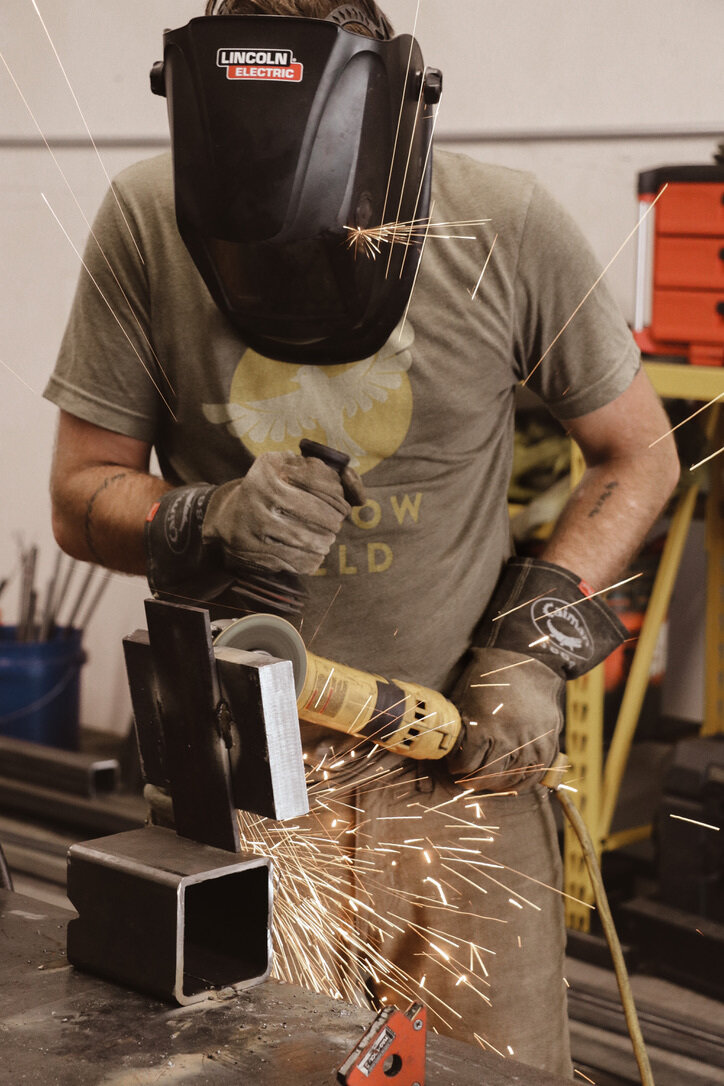Is Welding Dangerous?
The short answer is, yes. There are many factors that go into workplace safety and each individual bears the responsibility to conduct themselves in a way that keeps themselves and those around them out of harms way. Welding and fabrication require working with sharp tools and hot metals, but these hazards don’t need to mean injury is inevitable. Minor workplace accidents can happen to the best of us, but nearly all major accidents are possible to prevent. Long term exposure to fumes and radiation can cause harm, but luckily some precaution and protective equipment can go a long way to prevent unnecessary hazards.
Acute Hazards
Potential hazards that can be encountered on a day-to-day basis, not including Sean when he’s in a bad mood.
Communication (or lack thereof)
Communicating with your team is perhaps one of the most important and simple ways to stay safe. Make sure to let those around you know if you’re about to start welding or grinding so they can move, as to not get flash-burned or hit by sparks. When moving heavy pieces with others, let them know when you’re putting it down so they don’t crush their fingers or trap themselves with something heavy. Making sure there is a clear leader to each operation and only one person giving directions at a time can be important in certain situations. We are all leaders but when lifting heavy items, one voice is all that is needed. In general, just be aware of other people working around you and be sure to communicate properly to everyone within the team.
Cuts
Grinding and cutting wheels, saws, and sharp metals are responsible for most cuts in the shop. Wearing work gloves, using guards for grinding and cutting wheels, and keeping your body out of the line of your tools should prevent most injuries of this kind. Often it is the little thing that gets you like a sheet metal edge hanging off the table slightly or picking up something that was freshly cut that has a razor sharp burr. After a little time in the industry, you’ll develop a sixth sense about how to handle materials to avoid these minor scrapes and cuts, but they are at times just a part of the job.
Burns
The metal joining process from MIG welding can reach more than 3,000ºF, and sparks from grinding can be up to 4,500ºF. Many of the tools and metals we are working with will at some point be hot enough to burn us. Always assume metal is hot. It’s a good idea as well to mark it when it is too. Use tools rather than your hands to manipulate metal after you’ve just welded or used a grinder for a prolonged period of time. Wear long sleeved clothing when possible to protect your skin from sparks and bright light.
Eye damage
Eyes are helpless and not very tough. It’s important to protect them because they don’t take a lot of abuse before they can have lasting damage. In our industry there are many hazards for eyes. Sparks can bounce around hats and hoods and end up in your eye, and looking at a welding arc without proper PPE can give you a flash-burn, which can leave a sunburn on your retina. Vision loss is possible in extreme cases or where this type of damage consistently occurs. Always wearing safety glasses is a good habit to be in. Safety glasses serve as a barrier to keep things, like sparks or dust, from getting in your eyes, and they also block harmful UV light from the welding process to mitigate or prevent eye damage from light as well.
Long-term Hazards
Welding shops often contain hazardous fumes, noise, and radiation.
Fumes
Welders are at risk of developing occupational asthma, and a 30 to 40% increased risk of developing lung cancer. Studies show that exposure to manganese, which is in mild steel welding fumes, can lead to neurological symptoms similar to Parkinson’s disease. Make sure you are in a well-ventilated area and avoid small, confined spaces. It is also important to be thoughtful about keeping your head out of the smoke plume to let these gases dissipate. Many beginners like to be up close to all the action when they first begin to see their welds better. With a bit of practice, you can learn to keep a safer distance and breathe in better air. In situations where air quality is difficult to maintain, respirators and air treatment may be the best option.
Noise
Noise above 70 dB for a prolonged period of time can lead to hearing loss, and many welding shops reach 95 to 105 decibels. Muffling headphones and earplugs can block 15 to 30 dB. Opt for earplugs for low frequencies and headphones for high, or double up for extra protection. You can never go wrong with TOO much protection. If you happen to have headphones with a radio system and microphones, make sure you finish each sentence with “over and out,” or others might not be overly aware that you’re finished talking. It is also important to be thoughtful of others. Sometimes the background noise is just part of the day, other times it may be considerate to let your team know before you clang a hammer across a piece of steel at full force. Give them a chance to get their hearing protection in if they don’t already, and make sure nobody is going to have a heart attack and fall off a ladder from their startle response.
Radiation
Welding releases ultraviolet and sometimes infra-red light, which can cause effects to the skin similar to extreme sunburns, and skin cancer in the case of long term UV radiation. Wear clothing that will cover most if not all exposed skin while welding. Many welders just wear t-shirts, not as a bad attempt to get a tan, but as a less-bad attempt to keep cool. Heat stroke is no joke either. If you can withstand the heat, it’s better to be protected. You should ideally go for fire-resistant clothing, but if you’re making due with clothes you already own, make sure the fabric is tightly woven cotton or wool. Avoid synthetics and anything with frays or strings that could catch on tools. If you need help on deciding what to get or what brands may or may not work best, Sean wrote an article of his opinion on this exact subject. The article is call Construction Clothing. Check it out!
Sources
https://www.hse.gov.uk/welding/health-risks-welding.htm
https://www.osha.gov/laws-regs/standardinterpretations/2009-10-08
https://vernlewis.com/is-mig-welding-safe-and-effective/
https://www.osha.gov/welding-cutting-brazing/hazards-solutions
https://www.safeworkaustralia.gov.au/system/files/documents/1705/mcop-welding-processes-v1.pdf






